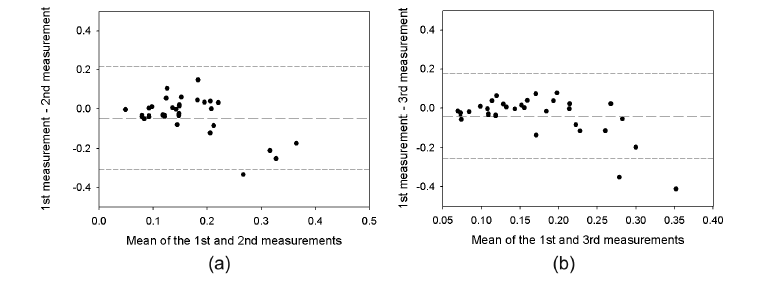Purpose: To evaluate intersession and intrasession repeatability of aberration data obtained with a new visual simulator based on adaptive optics, which includes a Hartmann-Shack aberrometer (Adaptive Optics Vision Analyzer; Voptica S.L., Murcia, Spain).
Methods: Thirty-one healthy right eyes were included in the study. To evaluate intrasession repeatability, three consecutive measurements without repositioning the
patient or realigning the eye were obtained. Intersession repeatability was evaluated in three sessions. Aberrometric data computed from the second to the fifth order for a 4-mm pupil were used. Statistical analysis included the repeated measures analysis of variance (or the Wilcoxon signed rank test), the coefficient of repeatability, the Bland–Altman method, and the intraclass correlation coefficient.
Results: No significant differences in the intrasession and intersession repeatability analysis for any of the parameters (P > .05) were found, suggesting a consistent
variability of the instrument over time. Similar coefficient of repeatability values were obtained in the three sessions. The Bland–Altman analysis confirmed differences close to zero and the variations were independent of the mean within and between sessions. The intersession intraclass correlation coefficient values were generally above 0.75, suggesting moderate to high repeatability. However, some exceptions were found in the intrasession analysis.
Conclusions: The findings suggest that the new instrument provides consistent and repeatable aberrometric data. It is therefore a suitable tool to perform consistent and repeatable visual simulations.
Buscar
Categorías
Archivos
- diciembre 2025 (2)
- octubre 2025 (7)
- junio 2025 (2)
- mayo 2025 (1)
- marzo 2025 (4)
- diciembre 2024 (4)
- octubre 2024 (5)
- septiembre 2024 (1)
- julio 2024 (8)
- junio 2024 (1)
- mayo 2024 (1)
- marzo 2024 (1)
- octubre 2023 (2)
- julio 2023 (5)
- junio 2023 (1)
- julio 2022 (10)
- mayo 2022 (1)
- marzo 2022 (1)
- julio 2021 (5)
- marzo 2021 (2)
- octubre 2020 (36)
- septiembre 2020 (122)
- agosto 2020 (10)
- julio 2020 (38)
- abril 2020 (1)
- diciembre 2019 (1)
- abril 2018 (1)
- septiembre 2017 (2)

Repeatability of Aberrometric Measurements With a New Instrument for Vision Analysis Based on Adaptive Optics
- Voptica
- Publicaciones de VAO
Journal:
Journal of Refractive Surgery
Year:
2015
Link:
Authors:
Carles Otero, Meritxell Vilaseca, Montserrat Arjona, Joan A. Martínez-Roda, Jaume Pujol